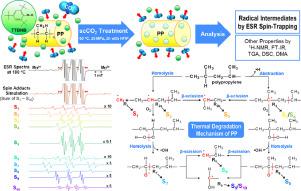Polymer Degradation and Stability ( IF 6.3 ) Pub Date : 2022-02-15 , DOI: 10.1016/j.polymdegradstab.2022.109871 Thu Anh Nguyen 1 , Shota Ichise 2 , Kenji Kinashi 3 , Wataru Sakai 3 , Naoto Tsutsumi 3 , Satoko Okubayashi 4

|
The thermal degradation mechanism of poly(propylene) (PP) fabric from room temperature to 220 °C was analyzed using the electron spin resonance (ESR) spin-trapping technique. This method was adopted to prolong the lifetime of the short-lived radical intermediates generated by thermal degradation with the object of inspecting their molecular structure. A spin-trapping reagent, 2,4,6-tri‑tert-butylnitrosobenzene (TTBNB), was impregnated into the PP fabric using supercritical CO2 (scCO2) treatment in the presence of a co-solvent. The impregnation efficiency and effect were evaluated using proton nuclear magnetic resonance (1H NMR) spectroscopy, Fourier-transform infrared (FT-IR) spectroscopy, and scanning electron microscopy (SEM). ESR analysis showed that the degradation of PP is initiated from the tertiary carbon positions via two pathways: homolysis to generate ·CH3 and −CH2−·CH−CH2− radicals, and hydrogen abstraction to generate −CH2−·C(CH3)−CH2− radicals. These radicals are also attacked by oxygen to form hydroperoxides, which then decompose to form the alkoxy radicals −CH2−CH(O·)−CH2− and −CH2−C(CH3)(O·)−CH2−. These radicals are involved in the subsequent β-scission reactions that produce primary and secondary carbon radicals. Alkoxy radicals also take part in the β-scission reactions involving the main chain carbon radicals, which have a hydroxyl group in the β-position, and in hydrogen abstraction from a five-membered ring at temperatures higher than the melting-point to produce an α‑hydroxyl carbon radical, ·CH(OH)−. These inferred processes involved in the thermal degradation of PP fabric were supported by other methods of analysis, including differential scanning calorimetry (DSC), thermogravimetric analysis (TGA), and dynamic mechanical analysis (DMA).
中文翻译:

聚丙烯热降解的自旋俘获分析
使用电子自旋共振 (ESR) 自旋捕获技术分析了聚丙烯 (PP) 织物从室温到 220 °C 的热降解机理。该方法用于延长热降解产生的短寿命自由基中间体的寿命,目的是检查它们的分子结构。在共溶剂存在下,使用超临界 CO 2 (scCO 2 ) 处理将自旋捕获试剂 2,4,6-三叔丁基亚硝基苯 (TTBNB) 浸渍到 PP 织物中。采用质子核磁共振(1H NMR) 光谱、傅里叶变换红外 (FT-IR) 光谱和扫描电子显微镜 (SEM)。ESR分析表明,PP的降解从叔碳位置开始,通过两条途径:均裂产生·CH 3和-CH 2 -·CH-CH 2 -自由基,以及夺氢产生-CH 2 -·C( CH 3 )-CH 2 - 自由基。这些自由基也被氧攻击形成氢过氧化物,然后氢过氧化物分解形成烷氧基自由基-CH 2 -CH(O·)-CH 2 - 和-CH 2 -C(CH 3 )(O·)-CH 2 - . 这些自由基参与了随后的产生初级和次级碳自由基的β-裂变反应。烷氧基自由基还参与涉及主链碳自由基的β断裂反应,该反应在β位具有羟基,并在高于熔点的温度下从五元环中夺取氢以产生α-羟基碳自由基,·CH(OH)-。这些与 PP 织物热降解有关的推断过程得到了其他分析方法的支持,包括差示扫描量热法 (DSC)、热重分析 (TGA) 和动态力学分析 (DMA)。






























 京公网安备 11010802027423号
京公网安备 11010802027423号